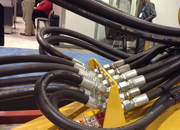Types of Hydraulic Hoses
2022-10-10 14:38:02
Hydraulic hoses are used for a variety of applications. The type of hose you choose will depend on the type of work you'll be doing and the pressure that will be applied. For bending applications, you might choose a flexible hydraulic hydraulic hose or a rigid hydraulic hydraulic hose. It is important to know the minimum radius bend and maximum pressure rating in each case. This information can be obtained from the manufacturer or third-party reference guides.
hydraulic spray hose
Hoses are used for hydraulic applications and are extremely flexible. They also have improved heat and corrosion resistance. They can be fabricated in a variety of ways. There are many factors that affect the durability of a hose, including the type of fitting used and the pressure applied. Spiral wire hoses are more durable than braided hoses. However, it is important to change the oil and filter regularly to ensure maximum life.
The hoses made by the top manufacturers are more resistant to temperature changes and lighter in weight. This makes them suitable for a variety of applications. In the mining, construction and oil refining industries, they are highly in demand. These hoses can withstand temperatures up to +212degC.
sae 100r6 Rotary decoking Hose
SAE 100R6 rotary decoking hose is made from a special synthetic rubber that is hydraulic oil resistant. It is reinforced with high tensile synthetic textile braid. It also comes with a thermoplastic cover. It is recommended for general purpose oil and water lines.
This hose is made for low-pressure hydraulic applications and is suitable for water-based and petroleum-based hydraulic fluids. The hose has three parts: inner cylinder, cover, and outer hose. Its rot-resistant cover makes it a key feature.
SAE 100R6 rotary decoking hose is commonly used in a vacuum or suction and return line. It can also be used for anti-static or drilling applications. It is made from weather-resistant synthetic rubber oil and steel wire spiral. The hose can withstand temperatures from -40 to +100 degrees Celsius.
heat resistance sandblasting rubber hose
A heat resistant sandblasting rubber hose has two main features: a thick rubber cover and a tough, durable inner layer. These two features make the hose ideal to be used in abrasive applications. The hose's cover is made from a weather-resistant SBR/NBR rubber material that resists heat, abrasion and wear.
This heat-resistant hose is designed for general-purpose sandblast applications and has excellent kink resistance and excellent resistance to abrasive materials. It also has a static conductive tube for protection against static electricity. The hose also has a lighter, thinner wall than conventional sandblasting rubber hoses. It can be split into rolls or sold in a stock form.
Heat resistance sandblast hoses are made of rubber and are used in the stonework, mining, and marine industries. They are also used in chemical plants and shipyards to transfer hot steam.